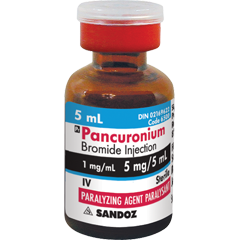Pharmacology definition - Pancuronium

Pancuronium
Pancuronium is useful as an adjunct to the induction of general anesthesia. Pancuronium is useful during the endotracheal intubation by relaxing the skeletal muscle and reducing the contraction of skeletal muscle.
Pancuronium may include cisatracurium, atracurium, mivacurium and vacuronium. Pancuronium will competitively bind to the nicotinic receptors at the neuromuscular junction. Pancuronium will prevent the binding of the acetylcholine which will activate the nicotinic receptors. Pancuronium is known as non depolarizing neuromuscular blocker which will cause the neuron to be inactivated and preventing the contraction of the skeletal muscle.
The level of acetylcholine in neuromuscular junction can be raised by administrating cholinesterase inhibitor such as neostigmine. This will overcome the binding of pancuronium to the nicotinic receptor.
The common side effects of pancuronium may include tachycardia, respiratory depression and hypotension.
Pancuronium is useful as an adjunct to the induction of general anesthesia. Pancuronium is useful during the endotracheal intubation by relaxing the skeletal muscle and reducing the contraction of skeletal muscle.
Pancuronium may include cisatracurium, atracurium, mivacurium and vacuronium. Pancuronium will competitively bind to the nicotinic receptors at the neuromuscular junction. Pancuronium will prevent the binding of the acetylcholine which will activate the nicotinic receptors. Pancuronium is known as non depolarizing neuromuscular blocker which will cause the neuron to be inactivated and preventing the contraction of the skeletal muscle.
The level of acetylcholine in neuromuscular junction can be raised by administrating cholinesterase inhibitor such as neostigmine. This will overcome the binding of pancuronium to the nicotinic receptor.
The common side effects of pancuronium may include tachycardia, respiratory depression and hypotension.
